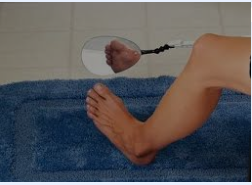Diabetic Foot Care is of the greatest importance. You must take care of your feet. Poor foot care may lead to devastating results. Daily foot care is the answer. When done correctly, existing problems are monitored and new problems are told to your M.D. or your Podiatrist at once. From the CDC website “Diabetes and Your Feet” If you have diabetes, here’s a way to keep standing on your own two feet: check them every day—even if they feel fine—and see your doctor if you have a cut or blister that won’t heal.
Tips for Healthy Feet
Check your feet every day; For cuts, redness, swelling, sores, blisters, corns, calluses, or any other change to the skin or nails.
Wash your feet every day; In warm (not hot) water. Don’t soak your feet. Dry your feet completely and apply lotion to the top and bottom—but not between your toes, which could lead to infection. This is very important in diabetic foot care
Do Not go barefoot: Diabetics should Always wear shoes and socks or slippers, even inside, to avoid injury. Check that there aren’t any pebbles or other objects inside your shoes and that the lining is smooth.
Wear shoes that fit well; For the best fit, try on new shoes at the end of the day when your feet tend to be largest. Break in your new shoes slowly. Wear them for an hour or two a day at first until they’re completely comfortable. Always wear socks with your shoes.
Trim your toenails straight across, And gently smooth any sharp edges with a nail file. Have your foot doctor trim your toenails if you cannot see or reach your feet.
Don’t remove corns or calluses yourself, and don’t use over-the-counter products to remove them—they could burn your skin causing additional problems.
Keep the blood flowing; In your diabetic foot care routine. Put your feet up when you’re sitting, and wiggle your toes for a few minutes several times throughout the day.
Choose feet-friendly activities; Like walking, or swimming. Check with your doctor about which activities are best for you and any you should avoid.
Daily Foot Inspection.
Set up what’s needed. Warm water[not hot], mild soap, soft towel, mirror- if assistance is needed to inspect the sole, and no one is available to help. Lotion, clean socks: Wash feet gently. Between toes; inspecting as you go along.

- Exiting problems, better; same or worse.
- Temperature; same as usual, hot or cold, and is that new?
- Color; usual, redness or increased redness, pale, or bluish.
- New; scratches, cuts, blisters, tenders spot with touch, skin breaks.
- If anything noted gives you cause for concern call your Doctor or your Podiatrist at once. On completion, Pat’s feet dry, [do not rub] especially between the toes. Apply lotion for dry skin, and to prevent dry skin. Never between the toes. Socks and shoes. For any newly opened areas or blisters, cover them with a band-aid and call the Doctor. NEVER pick at open areas or a blister
Assistance with foot care
If you have difficulty, inspecting the sole of your feet, or your vision is poor, having a family member or friend, help will be necessary. Otherwise, you can use a mirror, magnifying side up. From a sitting position, hold your foot over the mirror, take your time, and inspect. Your Podiatrist will perform nail clippings. If you must do it yourself; after washing-when they are soft, nail clippers, cut the nail straight across; then gently file with an emery board to remove sharp edges. Avoid cutting into the corners of the toes. Having a podiatrist is important, Additionally, some makes house calls every 6 weeks. And for Medicare and Medicaid patients; this care is covered.
Proper footwear

The proper footwear is of vital importance. Well-fitting shoes/ boots that will protect your feet from cold and moisture; No high heels or pointed toes;1/2 inch longer than your longest toe; Close toes and heels; Outer sole made of stiff material; Uppers without seam inside; soft insides without rough areas, with the correct support are needed. If ordered by your M.D. or podiatrist, you will get special diabetic shoes. Avoid exposure to extreme temperature; Sock; Change socks daily; use a synthetic blend, that wicks away moisture and discourages fungus; Furthermore, seamless, and warm; should not be tight or have a tight band at the top, light color, and lightly padded. Diabetic socks are available and, take away the worry of buying the correct socks. Do not use hot water bottles, or heating pads to warm your feet. Wear socks to sleep if your feet are cold.
Thanks for visiting. I hope the information on this page was of help to you.
We are available to Contact with Regard to This site: See How by CLICKING HERE

